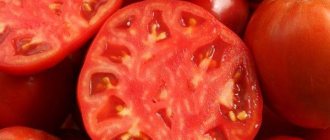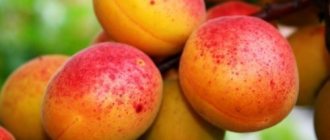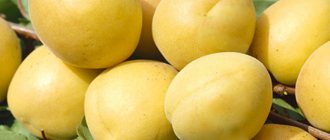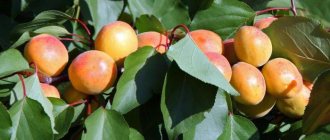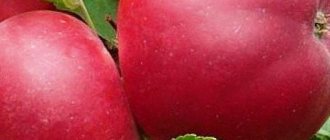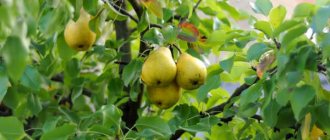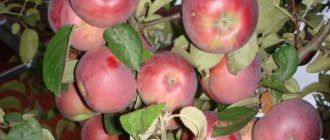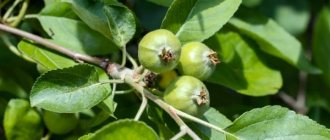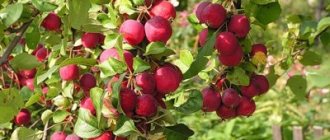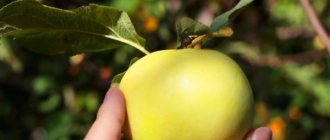History of the variety's creation
This apricot was bred by famous Russian breeders Skvortsov and Kramarenko, who introduced a new apricot tree at the end of the last quarter of the last century.
When developing a new variety of apricot, these scientists wanted to create a fruit tree that would be highly resistant to frost, characterized by early fruit ripening, and would be zoned for cultivation in the middle zone and regions with similar climatic conditions.
Apricot Alyosha - photo
As a result, after the tests, the new apricot variety Alyosha was included in the State Register of Russia at the beginning of this century
.
Over the past years, the Alyosha variety has been appreciated by many gardeners who planted it on their plots (in the middle zone and other areas of the Central region).
Characteristics
The variety is intended for cultivation in the Moscow region and other regions of the middle zone. In the appropriate climate, the fruit tree produces a stable harvest of apricots every year, without requiring significant effort from the gardener.
Drought resistance, winter hardiness
This unpretentious variety tolerates frosty winters well. If there is low air temperature in spring, it is recommended to whiten the tree trunk in a timely manner to delay flowering. A distinctive characteristic of the Alyosha apricot variety is its ability to tolerate dry weather. A long-term decrease in soil moisture may have a slight effect on the taste of the fruit.
Pollination, flowering period, ripening time
The fruit tree variety begins to bear fruit after 3-4 years. Ovaries are formed on all types of shoots. The flowering period, as a rule, occurs in the third ten days of April or the beginning of May. Pollinators are not required for the Alyosha apricot. The self-fertile variety can itself act as a pollinator for other apricot trees. During flowering, the entire crown is strewn with large flowers.
Early fruit ripening begins in mid-summer. From the second half of July to mid-August, technical ripeness of apricots begins. The yield of the variety is high, more than 40 c/ha.
Area of application of fruits
Apricots of the Alyosha variety are consumed fresh, and compotes and jams are prepared from them. The harvest collected from the branch can be stored for a long time and not spoil. Fruits are suitable for transportation over short distances.
Important! From juicy fruits you can get healthy and tasty apricot juice with a pleasant sourness.
Resistance to diseases and pests
The Alyosha variety demonstrates high immunity to diseases characteristic of fruit trees, especially monoliosis and klyasterosporiosis. These fungal diseases lead to premature death and shedding of foliage and ovaries. The reason for the spread of diseases is sharp temperature fluctuations and high humidity.
Reviews from gardeners about the Alyosha apricot indicate resistance to pests. With proper care and suitable climatic conditions, the tree does not need additional protection.
Advantages and disadvantages
Alyosha is a popular variety for growing in central Russia.
Apricot received recognition from gardeners due to several advantages:
- early fruit ripening;
- ability to withstand winter temperatures down to -30°C;
- resistance to pests and diseases;
- high yield and taste of ripe apricots;
- transportability and keeping quality of fruits.
In accordance with the description of the apricot Alyosha, the only disadvantage is the large mass of the stone, which increases the percentage of waste during fruit processing.
Apricot Alyosha: characteristics and description of the variety
The Alyosha apricot has a spreading, rounded crown up to 3.5 m high, medium-thick branches with good formation of lateral shoots
. The branches are medium leafy, flowering begins before young leaves appear. The foliage is less than medium in size, oval at the base, with sharp tips. The central vein is clearly visible. The color of the leaf blades is rich green, but with the onset of autumn the leaves acquire shades of yellow, crimson and red.
Photo of apricot Alyosha
The flowers are small, 3.5-4 cm in diameter, the color of the blooming buds is pink, as they bloom the petals become white with a slight shade of pinkish.
Ovaries are formed on different types of shoots. During the flowering period, the tree is completely covered with blooming pinkish-white buds.
On a note!
Alyosha apricots begin to ripen in the second ten days of July, but final ripening can occur before the first ten days of August.
Ripe fruits are round, slightly laterally compressed, with light yellow pubescence
. The color of the skin is bright yellow with a reddish “blush”. The pulp is sweet with slight sourness, bright orange in color. The pit is quite large, can account for about 17% of the volume of the fruit; in ripe apricots it is easily separated from the pulp.
The fruits contain a large amount of potassium - up to 370 mg per 100 g of product. The amount of dry matter is 14%, sugars are 8.2%.
Important!
300 g of ripe apricots contain the daily requirement of provitamin A.
When growing this fruit tree in the middle zone, gardeners practically do not have to make any special efforts to obtain stable high yields.
.
The harvested crop is characterized by good transportability; when harvested slightly unripe, it can be stored in appropriate conditions for a long time.
Ripe fruits can be eaten fresh, or cooked into aromatic jam and topped with compotes. A delicious juice is also prepared from these fruits.
Advantages and disadvantages
The main advantages of the apricot variety Alyosha are:
- early fruit ripening;
- has frost resistance, can withstand frosts down to -28-30 degrees Celsius;
- the variety has high immunity, therefore it is practically not affected by various diseases;
- fruiting is stable and high;
- the taste of the Alyosha apricot fruit is excellent;
- The harvested crop tolerates transportation well and can be stored for quite a long time.
The only drawback, according to gardeners, is that the pit size is too large, which increases the volume of waste when canning apricots.
Apricot Alyosha: how to plant seedlings correctly
Experts recommend purchasing seedlings of the Alyosha apricot variety in specialized nurseries
. In this case, the supplier guarantees that the variety meets the required requirements, as well as that the purchased planting material will be healthy and strong. Typically, such seedlings are sent with a closed root system, while the root system is not damaged, and the trees quickly take root in a new location.
Trees of the Alyosha variety with an open root system are planted in a permanent place in late March - early April
, when the earth is heated to a temperature of 6-9 degrees Celsius.
With further heating of the soil, the apricot will begin to rapidly grow roots and branches.
Planting apricots in a simple way.
Alyosha apricot seedlings with a closed root system are recommended to be planted at any time from the beginning of April to the second ten days of August
. At a later date, this fruit crop is not planted, since the trees will not have time to take root and will freeze out with the onset of cold weather.
The yield and taste of Alyosha apricot fruits directly depend on the area in which it is planted
. For it, it is better to choose a well-lit place that is protected from gusts of the north wind.
Important!
When planting an apricot in shade or partial shade, fewer ovaries will form on it in the future, and the apricots themselves will be tougher and too sour.
The roots of this tree are located close to the surface of the earth, but care must be taken to ensure that groundwater is not too close to the root system. Excessive soil moisture can cause cracking of the trunk, as well as rotting of the root system.
It is not recommended to plant shrubs next to this fruit tree, in particular currants or raspberries.
Before planting, branches of apricot seedlings are shortened by about a third, and dry sections of roots are also removed.
The planting hole must be at least 0.7 m deep, and its diameter depends on the size of the tree’s root system.
A layer of drainage 5-6 cm thick is laid out at the bottom of the hole.
, then a mound is formed from the nutrient substrate in the center, next to which a stake is driven. The seedling is placed on this elevation, tied to a peg, and the roots are carefully straightened along the slopes.
The hole is filled with soil from above, leaving the root collar 5 cm above the soil level. The soil is well compacted and 30-40 liters of water are poured under each tree. A properly planted apricot will take root completely within 25-30 days and begin to actively grow.
Fruit trees:
Voronezh Peach Pear variety Marble Plum Alyonushka
Features of planting a tree
Alyosha apricots are grown exclusively in well-lit areas. The soil should be sandy or loamy. If you simply plant a tree in sandy or clay soil, the development of the crop will slow down. Acidity acceptable for wood is 7.0 pH.
Interesting!
You can plant an apricot next to a building (house, gazebo, barn, garage). Thanks to such protection from the wind on at least one side, it will be much easier for the tree to endure the winter cold. However, you should not plant the crop on the north side of the house - it is usually cool there and the apricot may suffer from a lack of heat and light.
If several seedlings are planted, then a space of 3-4 meters must be left between them so that the trees can develop normally without interfering with each other. Saplings with a bare root system are planted from March to May, and with closed roots - at any convenient time, but preferably in spring or early autumn.
After planting, the soil is compacted and the tree is watered
The planting hole is prepared in 2 weeks. Its approximate dimensions are 1 meter in diameter and the same depth. The earth is dug up, drainage is made at the bottom with a layer of 10 cm. The soil for planting is mixed from the top layer of soil from the hole, 1-2 buckets of humus, superphosphate (100 g) and potassium salt (40 g). You can add wood ash (about a liter jar).
During planting, a mound of prepared soil is poured onto the drainage layer. A seedling is placed on it, the roots are straightened. After this, you need to gradually cover the roots with soil. The root collar cannot be buried. It should rise above ground level by about 5 cm! After planting, the soil is compacted and the tree is watered. If the soil has settled, you can fill it up.
Further care for the Alyosha variety
First of all, after planting, formative pruning of seedlings is carried out. In this case, no more than 6 shoots are left, each of which is shortened by about a third. As a result, the young tree develops an even, rounded shape. In the future, growing branches should be trimmed every autumn to maintain the shape of the crown.
Watering is carried out in spring and early summer, when the tree needs moisture for abundant flowering and formation of ovaries
. In the future, watering is reduced and carried out only during periods of prolonged drought.
Fertilizing apricots Alyosha
Before buds appear on the tree, it is recommended to apply any fertilizer containing nitrogen to the apricot tree trunk. It is better to use humus, compost or cow manure (rotted) for this.
In the fall, it is recommended to apply a mixture of any potassium salt and superphosphate under this tree.
Diseases and pests
The Alyosha variety is characterized by high immunity. The fruit tree is resistant to fungal diseases that are often found among its fellows. As a preventative measure, it is recommended to promptly carry out sanitary pruning of dry, damaged shoots, and spray trees with fungicides if there are diseased specimens in the garden. Every autumn the lower part of the trunk should be treated with whitewash to repel pests.
It is advisable to periodically dig up the soil around the tree to destroy caterpillars and harmful larvae. It is recommended to regularly inspect apricot foliage for the presence of aphids or codling moths. To control pests, it is necessary to spray trees with insecticides.
Apricot Alyosha: reviews from those who grow the variety
Of the large number of reviews from gardeners about this variety, only a few are given below.
Olga, Serpukhov region: This apricot has been growing on my plot for several seasons. This tree tolerates winters well, all diseases have so far passed my apricot tree by. The fruits are tasty, but rather small with large seeds. But after ripening they do not stay on the branches and fall off, and even crack. From carrion I make very tasty and aromatic jam, which all members of my family eat with pleasure.
Sergey, Podolsk: The self-pollinating apricot variety Alyosha grows well in our region. Although the apricot varieties growing in the south are much sweeter and juicier, the Alyosha apricot ripens earlier. The tree began to bear fruit two seasons after planting. And by the age of 5 it began to produce abundant harvests every year.
Experts recommend growing Alyosha apricot to gardeners living in central Russia
, because this variety is zoned precisely to such climatic conditions, the harvest ripens early, and all the fruits have time to ripen during a not too long warm summer.

